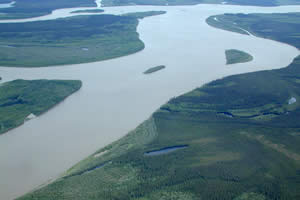Methylmercury Formation, Transport and Fate in the Yukon River, Alaska
Project Number: xxx
Project Chief: Dave Krabbenhoft
Project Topics: remote locations, baseline, mercury
Cooperators: list
Period of Project: yyyy to present
 Introduction Introduction
Although all ecosystems on the planet are surficially contaminated with mercury to some degree, generally the most remote locations are the least contaminated. However, very little is known about the actual contamination levels of extremely remote locations such as the Yukon Basin.
Establishing an accurate baseline for such locations is important for monitoring possible future changes from emissions reductions, as well as changes that may also arise from other global phenomenon like global warming.
For example, vast areas of the still relatively pristine Yukon Basin are permafrost peatlands, and if global warming predictions are accurate, widespread melting of the peat may occur and release mercury that has been accumulating for long periods of time, or potentially worse, melting could catalyze mercury methylation in the peat that is now not likely occurring.
For the Yukon River Basin study, we have accomplished or started several tasks that will allow for establishment of several critical baselines to detect possible future changes, and for establishing what currently contamination levels are in this extremely remote location, as follows:
- In the spring, summer and fall of 2001, we participated in a larger effort to plan and conduct a complete water chemistry sampling along the more than 2200 miles of the Yukon River, including mercury.
- In June, 2001, we participated in a survey of the Yukon River, including many of its important tributaries that drain possible mining enriched mercury areas.
- We participated in the scientific plan development for the Yukon River study, including providing the text for a fact sheet (published by Ed Landa) describing the mercury investigations for this study
Project hypotheses
1. Mercury methylation:
1a. Methylmercury is produced in the multitude of intra- and lateral-stream sloughs and wetlands of the Yukon River, and the annual flushing of these sub-ecosystems during spring runoff regulates observed fluxes of MeHg in the River itself.
1b. No new MeHg formation is currently active in the Yukon basin, and measurable fluxes of MeHg at the present are the result of mobilization of relic MeHg formed during warmer, wetter historical times, retained in frozen peat lands, and only recently mobilized by melting permafrost.
1c. Because MeHg formation is microbially mediated, warmer conditions would likely yield higher methylation rates in native soils and peat.
1d. Methylmercury levels in the Yukon Basin are generally low, and are reflective of abiotic methylation in the atmospheric and subsequent deposition of MeHg.
2. Mercury and methylmercury sources and transport in the Yukon River:
2a. Clear water tributaries and sloughs contribute "reactive" Hg and MeHg to the Yukon River, however, the high particulate loads quickly scavenge the Hg and MeHg from aqueous solution and limit the methylation and bioaccumulation processes.
2b. Glacial erosion and melt water mobilize "geologic" particulate mercury from watershed sources (both intact natural mineralized areas and areas contaminated by past or current mining activity) down gradient to the Yukon River, where sedimentation in methylmercury forming environments (sloughs and wetlands).
2c. Annual flooding and flushing of the Yukon Basin wetlands by snow and glacial melt water enriched in particulate mercury stimulates methylation due to the combined influences of inundation and mercury loading.
2d. Although spring floods bring high loads of particulate, inorganic mercury to the Yukon Basin, this mercury pool is largely unreactive and the more reactive and bioavailable mercury in rainfall is what drives MeHg formation.
3. Gaseous mercury production and fluxes:
3a. Gaseous mercury production and evasion is a result of photo reduction by UV light, and due to the continual sunlight conditions of high latitude sites, mercury depletion of wetland surfaces will results and limits MeHg formation.
3b. Gaseous mercury production and subsequent evasion from the water column is an important process in most ecosystems, however, the high turbidity of the Yukon River prevents (or greatly limits) this process.
3c. Although significant total mercury levels exist in the Yukon River, the majority is particulate and not sensitive to photo reduction by ultraviolet sunlight.
Project photos:
Click here for project photos >
|

